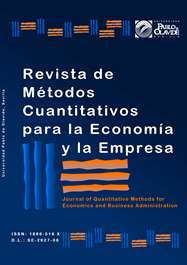// Fuzzy-Set Qualitative Comparative Analysis to Determine Effects from Socio-Economical Factors and University Students Performance
DOI:
https://doi.org/10.46661/revmetodoscuanteconempresa.2889Keywords:
economía de la educación, educación superior, análisis cualitativo comparativo, espacio europeo de educación superior, education economics, higher education, qualitative comparative analysis, European higher education areaAbstract
The objective of this paper is to explain academic performance with the aid of an innovative technique: Fuzzy-set Qualitative Comparative Analysis (fsQCA). To do so, different objective factors, which affect higher education, are analyzed and the academic performance of university students is also considered. Specifically, data of students on different degrees in the Faculty of Business Sciences of the Pablo de Olavide University of Seville since 2009 was used, but it is believed that the methodology described can be easily extrapolated.
Downloads
References
Aguilera, J.; Fedriani, E.M.; Delgado, B. (2014): "Institutional distance among country influences and environmental performance standardization in multinational enterprises". Journal of Business Research 67(11), pp. 2385-2392.
Alba, R.; Segundo, S.M. (1995): "The return to education in Spain". Economics of Education 14(2), pp. 155-166.
Barceinas, F.; Alonso, J.L.; Raymond, J.L.; Roig, J.L. (2000): "Los rendimientos de la educación en España". Papeles de Economía Española 86, pp. 128-148.
Becker, W.E.; Walstad, W.B. (1987): Econometric modelling in economic education research. Boston: Kluwer Nijhoff Publishing.
De la Fuente, Á.; Jimeno, J.F. (2012): La rentabilidad privada y fiscal de la educación en España. Madrid: Observatorio sobre Capital Humano en España, BBVA Research.
Dolado, J.J.; Morales, E. (2007): "Which factors determine academic performance of undergraduate students in economics?". CEPR Discussion Papers 6237, 22 pp.
Fedriani, E.M.; Hidalgo, M.A.; Romano, I. (2017): "The prediction of academic success of university students to optimize their performance", por aparecer.
IECA (2013): Sistema de Información Multiterritorial de Andalucía (SIMA). Sevilla: Instituto de Estadística y Cartografía de Andalucía.
INE (2009): Anuario Estadístico de España 2009. Madrid: Instituto Nacional de Estadística.
INE (2010): Anuario Estadístico de España 2010. Madrid: Instituto Nacional de Estadística.
INE (2011): Anuario Estadístico de España 2011. Madrid: Instituto Nacional de Estadística.
Navarro, M.L.; Marcenaro, O.D. (2003): "Condiciones de acceso y otras características del estudiante como determinantes del éxito en el primer curso universitario". En San Segundo, M.J.; Zorrilla, R. (eds.): Economía de la Educación: AEDE XII. Madrid: Asociación de Economía de la Educación, pp. 42-61.
Ragin, C. (2008): Redesigning social inquiry: Fuzzy sets and beyond. Chicago: Chicago University Press.
Raymond, J. (2002): "Convergencia real de las regiones españolas y capital humano". Papeles de Economía Española 93, pp. 109-121.
Rovira, S.; Puertas, E.; Igual, L. (2017): "Data-driven system to predict academic grades and dropout". PLoS ONE 12(2), pp. 1-21.
Tejedor, F.J.; García, A. (2007): "Causas del bajo rendimiento del estudiante universitario: propuesta de mejora en el marco del EEES". Revista de Educación 342, pp. 443-473.
Woodside, A.G. (2013): "Moving beyond multiple regression analysis to algorithms: Calling for adoption of a paradigm shift from symmetric to asymmetric thinking in data analysis and crafting theory". Journal of Business Research 66(4), pp. 463-472.
Woodside, A.G.; Zhang, M. (2013): "Cultural diversity and marketing transactions: Are market integration, large community size, and world religions necessary for fairness in ephemeral exchanges?". Psychology and Marketing 30(3), pp. 263-276.
Downloads
Published
How to Cite
Issue
Section
License
Copyright (c) 2017 Journal of Quantitative Methods for Economics and Business Administration

This work is licensed under a Creative Commons Attribution-ShareAlike 4.0 International License.
Submission of manuscripts implies that the work described has not been published before (except in the form of an abstract or as part of thesis), that it is not under consideration for publication elsewhere and that, in case of acceptance, the authors agree to automatic transfer of the copyright to the Journal for its publication and dissemination. Authors retain the authors' right to use and share the article according to a personal or instutional use or scholarly sharing purposes; in addition, they retain patent, trademark and other intellectual property rights (including research data).
All the articles are published in the Journal under the Creative Commons license CC-BY-SA (Attribution-ShareAlike). It is allowed a commercial use of the work (always including the author attribution) and other derivative works, which must be released under the same license as the original work.
Up to Volume 21, this Journal has been licensing the articles under the Creative Commons license CC-BY-SA 3.0 ES. Starting from Volume 22, the Creative Commons license CC-BY-SA 4.0 is used.










